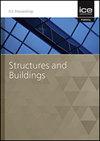Optimal location of acoustic emission sensors for detecting rail damage
IF 1.4
4区 工程技术
Q3 CONSTRUCTION & BUILDING TECHNOLOGY
Proceedings of the Institution of Civil Engineers-Structures and Buildings
Pub Date : 2022-08-25
DOI:10.1680/jstbu.21.00074
引用次数: 4
Abstract
For detection of cracks in rail sections, various experiments using the acoustic emission technique are carried out by earlier researchers. However, the literature suggests that the study on the optimum location of acoustic emission sensors for the detection of cracks in the railway track is rare. It is difficult to detect defects without the optimal placement of the sensor, due to the complex geometry of the rail section as well as the high cost of sensors. Hence an attempt was made toward the optimum placement of a single sensor on the rail section to detect cracks precisely. Pencil lead break, which simulates a crack, was applied in the rail section to initiate such a crack. The obtained signal was analysed using wavelet transformation to establish a relationship with the group velocity to localise the simulated crack. From the investigation, it was found that the optimum placement of the sensor was between 75 mm to 375 mm for a 1.9 m length of rail section in laboratory conditions.轨损声发射传感器的优化定位
为了检测钢轨断面的裂纹,早期的研究人员利用声发射技术进行了各种实验。然而,文献表明,对声发射传感器在铁路轨道裂缝检测中的最佳位置的研究很少。由于钢轨截面的复杂几何形状以及传感器的高成本,如果没有最佳的传感器位置,很难检测到缺陷。因此,我们尝试在钢轨截面上放置单个传感器以精确检测裂纹。在钢轨段采用模拟裂纹的铅笔芯断裂来引发裂纹。利用小波变换对得到的信号进行分析,建立与群速度的关系,对模拟裂纹进行局部定位。从调查中发现,在实验室条件下,对于1.9米长的轨道部分,传感器的最佳位置在75毫米至375毫米之间。
本文章由计算机程序翻译,如有差异,请以英文原文为准。
求助全文
约1分钟内获得全文
求助全文
来源期刊
CiteScore
3.40
自引率
6.20%
发文量
61
审稿时长
12 months
期刊介绍:
Structures and Buildings publishes peer-reviewed papers on the design and construction of civil engineering structures and the applied research associated with such activities. Topics include the design, strength, durability and behaviour of structural components and systems.
Topics covered: energy conservation, people movement within and around buildings, strength and durability of steel and concrete structural components, and the behaviour of building and bridge components and systems

 求助内容:
求助内容: 应助结果提醒方式:
应助结果提醒方式:


